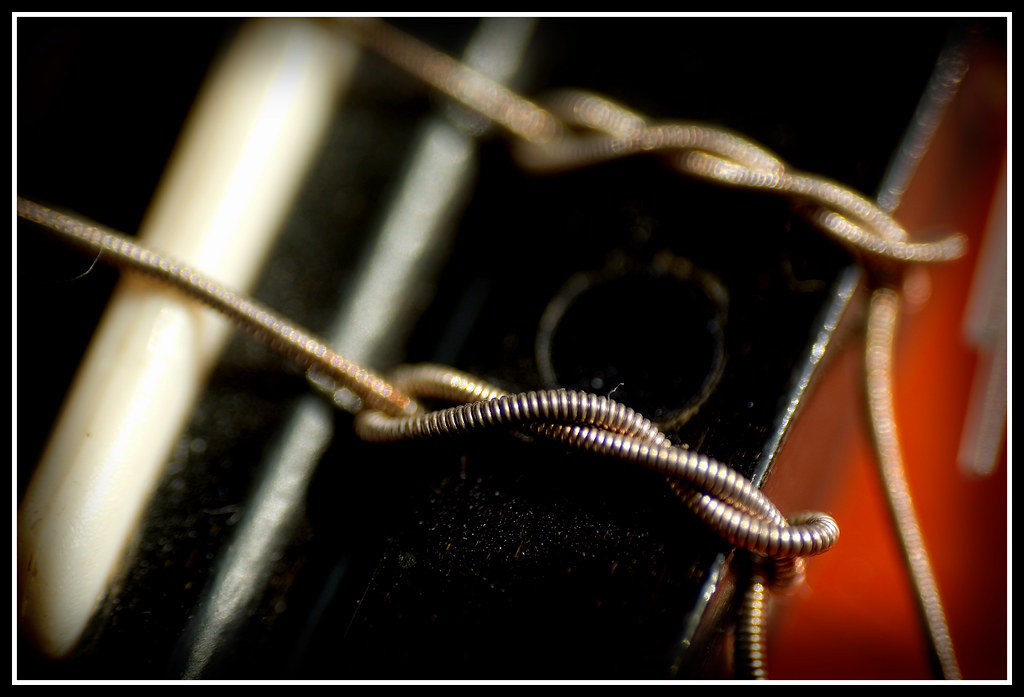
Guitar strings are strings, right? Not so. There are many different types of guitar strings, which can be made from metal wire or plastic. Each material has its own characteristics and properties. Your choice should depend on the sound you prefer and playability.
You will also find that many strings are composed of multiple materials; these are called wound strings. The inside core is composed of material “a” and the outside over-winding is made up of an entirely different material.
The construction (and material) changes the character, flexibility, and playability of the string. Keep in mind no string lasts forever. They wear out with usage and with time on the guitar.
You will know it is time to change them when your instrument does not want to stay in tune, does not sound as intense as before, or intonation becomes a problem.
You may also want to change them if you are concerned about their durability; the high e string has a tendency to break at the wrong time — i.e., when playing a gig.
Another good time to change them is when they oxidation and corrosion damage them. This is when they begin to rust from moisture when your hand sweats while playing the guitar.
Plain or wound?
Strings are either plain, which means it does not have an outer winding of additional material, or wound, which has an outer winding of wire material.
The small E and B string normally won’t be wound because they are so thin.
Acoustic and electric guitars strings are made from different materials because they each serve different purposes.
The core materials include metal, nylon, silk, gut.
Core materials
Metal: Steel wire is the core for electric guitar and bass strings.
The steel has magnetic properties, which allows the guitar pickup to pick up the sound.
Steel strings are the foundation for an electric instrument and will be what you want if you want to rock out. These sound bright when compared to nylon.
Nylon: Nylon strings are not used in electric instruments because they are not metal and the magnetic pickups on the instrument won’t pick up the sound.
These are mainly used in band instruments, like violins and cellos, but some classical acoustic guitar players will use them.
Silk: Silk is mainly used in classical string sets and produces a tone that is brighter than gut strings.
Gut: Gut strings are made from animal intestines. The plain, unwound strings have a tendency to break because of a musician’s sweat, but this is not an issue if they are wound with a metal winding. These strings are mainly used for guitarists who want to recreate a sound from the 17th century through the 19th century. If you are a rock ‘n’ roller, you don’t want these.
Types of acoustic strings
Although you can purchase acoustic strings in nylon, silk, or gut, chances are you will end up with a metal string on them. Two top acoustic guitar string materials are bronze wound and phosphor bronze wound.
Bronze wound
Bronze wound is commonplace on steel stringed acoustics. They are usually refereed to as 80/20 bronze because 80 percent of the string is made of copper and 20 percent tin.
80/20s have a very bright sound. The sound, however, dulls pretty quickly — after a few hours, actually.
They work well for recording work. You may find you want to change them every week or two if you play regularly.
Phosphor bronze wound
Phosphor Bronze Wound just adds phosphor to a bronze wound string. Why, you ask? It makes the original sound of the string last and provides a warmer sound.
Types of electric strings
You don’t need a degree in metallurgy to learn about the different types of electric guitar strings because there are three top electric guitar string materials.
Nickel plated
Nickel plated string feature a steel core that is wrapped with nickel plated steel.
The plating prevents the steel wire from corroding and oxidation. The magnetic properties of steel help you gain volume as the wire vibrates across the pickup.
Pure nickel
Pure nickel is just that — pure nickel wrapped around a core steel wire. The pureness of the nickel dulls down the string, causing it to be more mellow in tone. It will not be as loud, as well.
You will get a classic, vintage ’50s sound out of pure nickel wires. With that warm tone, they will also feel soft to the touch.
Stainless steel
Stainless steel is not as velvety smooth as nickel strings. Stainless steel is a hard material to touch and has a rough texture.
But the value is the bright sound and crunchy tone from these electric strings. They generate good volume through the pickups. They may cause your frets to wear quicker, though, so there is a trade off.
I hope this information about different types of guitar strings has been useful.
Originally posted 2023-01-06 16:08:54.


